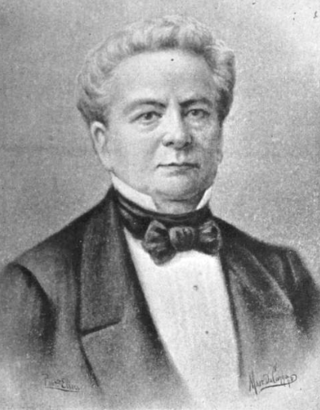
Chrysophyllum is a group of trees in the Sapotaceae described as a genus by Linnaeus in 1753.

Dipteryx charapilla is a little-known species of flowering plant in the family Fabaceae, a large to mid-sized tree growing along rivers in the rainforests of Brazil. and Peru.

Francisco Freire Allemão e Cysneiro was a Brazilian botanist who collected in northeast Brazil and along the Rio de Janeiro. His association with the Brazilian National Museum in Rio de Janeiro took place at a time when Brazilian botany was dominated by foreigners.

Chrysophyllum oliviforme, commonly known as the satinleaf, is a medium-sized tree native to Florida, the Bahamas, the Greater Antilles, and Belize. It is also known as damson plum, wild star-apple and saffron-tree. It gets the name "satinleaf" from the distinctive colors of the leaves. The top of the leaf is dark green while the bottom is light brown or copper. This distinctive look makes it a very aesthetically pleasing tree that is commonly used as an ornamental in yards and public spaces.
Chrysophyllum wilsonii is a tree in the family Sapotaceae, native to Brazil.
Chrysophyllum sparsiflorum is a tree in the family Sapotaceae, native to South America.
Chrysophyllum prieurii is a tree in the family Sapotaceae, native to South America and Panama.
Chrysophyllum pomiferum is a tree in the family Sapotaceae, native to tropical South America.
Chrysophyllum manaosense is a tree in the family Sapotaceae, native to tropical South America.
Chrysophyllum colombianum is a tree in the family Sapotaceae, native to Central and South America.
Chrysophyllum argenteum is a tree in the family Sapotaceae, native to the tropical Americas.
Chrysophyllum amazonicum is a tree in the family Sapotaceae, native to tropical South America.
Chrysophyllum durifructum is a tree in the family Sapotaceae, native to Brazil.
Chrysophyllum eximium is a tree in the family Sapotaceae, native to tropical South America.
Chrysophyllum ucuquirana-branca is a tree in the family Sapotaceae, native to tropical South America.

Chrysophyllum gonocarpum is a tree in the family Sapotaceae, native to South America.
Chrysophyllum lucentifolium is a plant in the family Sapotaceae, native to Central and South America.

Chrysophyllum marginatum is a tree in the family Sapotaceae, native to South America.
Chrysophyllum paranaense is a tree in the family Sapotaceae, native to Brazil.

Chrysophyllum splendens is a plant in the family Sapotaceae, native to Brazil.








